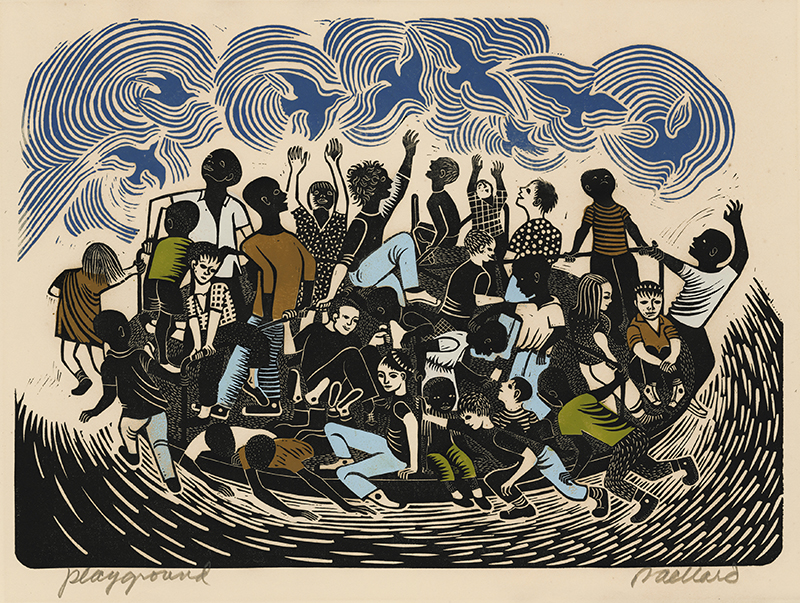Playground is a color linocut with screenprint from circa 1965 by American artist, Emmy Lou Packard. It is pencil signed and titled and, like most of her work, it is not editioned. Playground was printed by the artist on cream laid paper and the image measures 15-1/8 x 21 inches.
Playground is also known as Merry Go Round, Freedom Now, and Peace is Children’s Best Friend. Packard used her imagery as she found it appropriate to support her cause. This image was used for the 1980 Peace and Freedom Party’s poster, which is illustrated on page 12 in the exhibition catalogue Emmy lou Packard 1914-1998. Surrounding her image is letterpress text citing the Peace and Freedom Party’s candidates for President, Vice President, and Senator, along with a listing of what the party was advocating for: jobs, housing, real tax reform, free health care, no nukes, no draft, no war, right for undocumented immigrants, gay rights, child care, and abortion rights. The very rights we are still advocating for forty-two years later.
Emmy Lou Packard, painter, muralist, printmaker, photographer, sculptor, teacher, and social activist, was born on 4 April 1914 in El Centro, in the Imperial Valley of California. Her father was an internationally known agronomist and her parents helped to establish the agricultural cooperative community in which they lived. Her great-grandmother fought to obtain due process of law for woman. Emmy Lou’s courageous voice earned her international recognition as an artist and activist for peace.
Packard studied with Diego Rivera and Frida Kahlo in Mexico from 1927-1928. From 1932 to 1936, she studied at the University of California Berkeley, earning her B.A. While a student a Berkeley she was art editor of the Daily Californian, the student newspaper, and of Occident, the campus literary magazine. She continued her studies at the California School of Fine Arts, San Francisco, where she completed courses in fresco and sculpture. In 1940 she assisted Rivera with the 1,650 square foot fresco at the Golden Gate International Exposition at Treasure Island in San Francisco, and returned with him to Mexico City, where she was a guest of he and Frida Kahlo.
During World War II, Packard worked as an engineering drafter in defense industries, most notably in the Kaiser shipyards. During the late 1940s, she experimented with plastics in light sculptures, illustrated third-grade textbooks for the San Francisco public schools, organized the San Francisco Arts Festival, and was a co-founder of Artists Equity. In 1959, she created an eighty-five-foot-long bas-relief mural in cast concrete for the University of California Berkeley and it still hangs on the Cesar Chavez Student Center at Lower Sproul Plaza.
In both her art and writing, Packard championed the rights of women and children, and steadfastly supported the leadership of Cesar Chavez and the United Farmworkers. Her artistic studies of the Mendocino Headlands inspired her to become a key promoter in the establishment of the headlands as a national park.
She was included in numerous group exhibitions in Los Angeles and San Francisco and a solo exhibition of her paintings was mounted at the San Francisco Museum of Art (now the San Francisco Museum of Modern Art). Emmy Lou Packard’s work is represented in the collections of the Addison Gallery of American Art, Andover, Massachusetts; the British Museum, London; the Oakland Museum of California; the Fine Arts Museums of San Francisco, California; the Krannert Art Museum of the University of Illinois Urbana-Champaign; and the National Gallery of Art, Washington, D.C.
Emmy Lou Packard died on 22 February 1998 in San Francisco, California.
[Much of this bio is taken from Allen Temko’s tribute to Emmy Lou Packard published in May 2013.]



